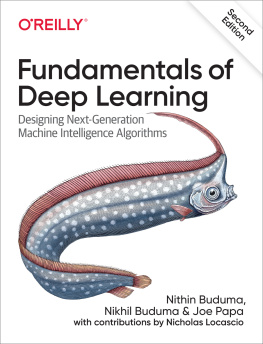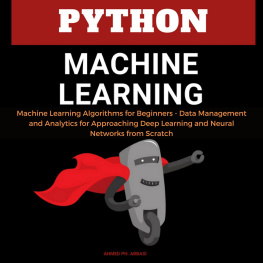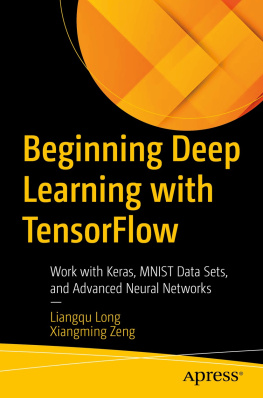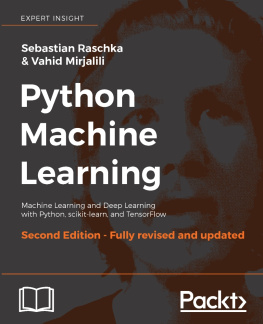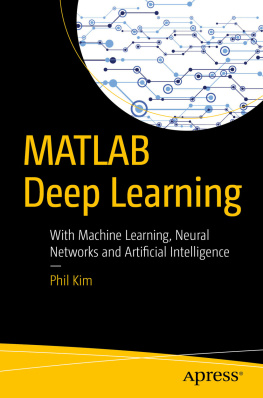Fundamentals of Deep Learning
by Nithin Buduma, Nikhil Buduma , and Joe Papa
Copyright 2022 Nithin Buduma and Mobile Insights Technology Group, LLC. All rights reserved.
Printed in the United States of America.
Published by OReilly Media, Inc. , 1005 Gravenstein Highway North, Sebastopol, CA 95472.
OReilly books may be purchased for educational, business, or sales promotional use. Online editions are also available for most titles (http://oreilly.com). For more information, contact our corporate/institutional sales department: 800-998-9938 or corporate@oreilly.com .
- Acquisitions Editor: Rebecca Novack
- Development Editor: Melissa Potter
- Production Editor: Katherine Tozer
- Copyeditor: Sonia Saruba
- Proofreader: Stephanie English
- Indexer: Judith McConville
- Interior Designer: David Futato
- Cover Designer: Karen Montgomery
- Illustrator: Kate Dullea
- June 2017: First Edition
- May 2022: Second Edition
Revision History for the Second Edition
- 2022-05-16: First Release
See http://oreilly.com/catalog/errata.csp?isbn=9781492082187 for release details.
The OReilly logo is a registered trademark of OReilly Media, Inc. Fundamentals of Deep Learning, the cover image, and related trade dress are trademarks of OReilly Media, Inc.
While the publisher and the authors have used good faith efforts to ensure that the information and instructions contained in this work are accurate, the publisher and the authors disclaim all responsibility for errors or omissions, including without limitation responsibility for damages resulting from the use of or reliance on this work. Use of the information and instructions contained in this work is at your own risk. If any code samples or other technology this work contains or describes is subject to open source licenses or the intellectual property rights of others, it is your responsibility to ensure that your use thereof complies with such licenses and/or rights.
978-1-492-08218-7
LSI
Preface
With the reinvigoration of neural networks in the 2000s, deep learning has become an extremely active area of research that is paving the way for modern machine learning. This book uses exposition and examples to help you understand major concepts in this complicated field. Large companies such as Google, Microsoft, and Facebook have taken notice and are actively growing in-house deep learning teams. For the rest of us, deep learning is still a pretty complex and difficult subject to grasp. Research papers are filled to the brim with jargon, and scattered online tutorials do little to help build a strong intuition for why and how deep learning practitioners approach problems. Our goal is to bridge this gap.
In this second edition, we provide more rigorous background sections in mathematics with the aim of better equipping you for the material in the rest of the book. In addition, we have updated chapters in sequence analysis, computer vision, and reinforcement learning with deep dives into the latest advancements in the fields. And finally, we have added new chapters in the fields of generative modeling and interpretability to provide you with a broader view of the field of deep learning. We hope that these updates inspire you to practice deep learning on their own and apply their learnings to solve meaningful problems in the real world.
Prerequisites and Objectives
This book is aimed at an audience with a basic operating understanding of calculus and Python programming. In this latest edition, we provide extensive mathematical background chapters, specifically in linear algebra and probability, to prepare you for the material that lies ahead.
By the end of the book, we hope you will be left with an intuition for how to approach problems using deep learning, the historical context for modern deep learning approaches, and a familiarity with implementing deep learning algorithms using the PyTorch open source library.
How Is This Book Organized?
The first chapters of this book are dedicated to developing mathematical maturity via deep dives into linear algebra and probability, which are deeply embedded in the field of deep learning. The next several chapters discuss the structure of feed-forward neural networks, how to implement them in code, and how to train and evaluate them on real-world datasets. The rest of the book is dedicated to specific applications of deep learning and understanding the intuition behind the specialized learning techniques and neural network architectures developed for those applications. Although we cover advanced research in these latter sections, we hope to provide a breakdown of these techniques that is derived from first principles and digestible.
Conventions Used in This Book
The following typographical conventions are used in this book:
ItalicIndicates new terms, URLs, email addresses, filenames, and file extensions.
Constant widthUsed for program listings, as well as within paragraphs to refer to program elements such as variable or function names, databases, data types, environment variables, statements, and keywords.
Note
This element signifies a general note.
Warning
This element indicates a warning or caution.
Using Code Examples
Supplemental material (code examples, exercises, etc.) is available for download at https://github.com/darksigma/Fundamentals-of-Deep-Learning-Book.
If you have a technical question or a problem using the code examples, please email .
This book is here to help you get your job done. In general, if example code is offered with this book, you may use it in your programs and documentation. You do not need to contact us for permission unless youre reproducing a significant portion of the code. For example, writing a program that uses several chunks of code from this book does not require permission. Selling or distributing examples from OReilly books does require permission. Answering a question by citing this book and quoting example code does not require permission. Incorporating a significant amount of example code from this book into your products documentation does require permission.
We appreciate, but do not require, attribution. An attribution usually includes the title, author, publisher, and ISBN. For example: Fundamentals of Deep Learning by Nithin Buduma, Nikhil Buduma, and Joe Papa (OReilly). Copyright 2022 Nithin Buduma and Mobile Insights Technology Group, LLC, 978-1-492-08218-7.
If you feel your use of code examples falls outside fair use or the permission given above, feel free to contact us at .
OReilly Online Learning
Note
For more than 40 years, OReilly Media has provided technology and business training, knowledge, and insight to help companies succeed.
Our unique network of experts and innovators share their knowledge and expertise through books, articles, and our online learning platform. OReillys online learning platform gives you on-demand access to live training courses, in-depth learning paths, interactive coding environments, and a vast collection of text and video from OReilly and 200+ other publishers. For more information, visit https://oreilly.com.
How to Contact Us
Please address comments and questions concerning this book to the publisher:

